Bottom Fishes
Freshwater gamefish such as trout and bass may not be taken by spear by divers. However, in some places, it may be legal to spearfish for carp, catfish, suckers, and other "rough" fishes - check local regulations.
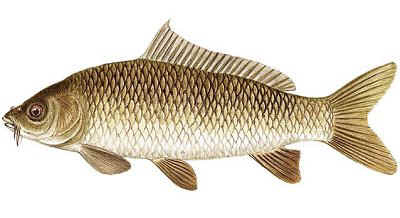
Cyprinus carpio
Size
to 36"
( record over 6 ft )
Description
A heavy-bodied, laterally compressed minnow with a long dorsal fin and arched back. The first ray of the dorsal and anal fins is a stout, serrated spine. The small triangular head tapers to a blunt snout. The small, protrusible mouth contains no teeth and is located below the snout. There are two pairs of barbels on the upper jaw. Body color is brassy green on top grading to bronze or gold on sides. The belly is yellowish-white. Fins typically are yellow, orange, golden, or light olive in color. The wild type of common carp is completely covered with large, round scales. Mirror carp has a few very large scales scattered over the body and leather carp are virtually scaleless.
More: Carp ...
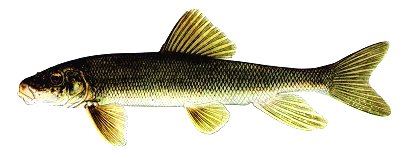
Catostomus commersoni
Size
to 25"
Suckers live in any kind of water, from fast-flowing streams to large lakes. They vacuum up invertebrates from lake and stream beds.
More: White Sucker ...
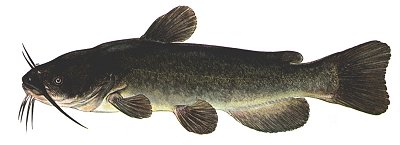
Ameiurus melas
Size
to 24"
Description
Ameiurus is Greek and means "primitive" or "curtailed" in reference to the slight notch in the caudal fin; melas is also Greek and means "black." Black bullheads are typically black to greenish-black on the back, ranging to gray or white on the belly. However, in muddy water, the back may be yellowish-brown. Chin barbels are dark or black, never white. The anal fin has 17-21 rays.
More: Black Bullhead Catfish ...
Percidae is the second largest family of fishes in North America, after Cyprinidae (Minnows). They are not related to saltwater Perches, which they superficially resemble.
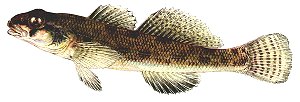
Darters are diminutive perches that inhabit quiet or slowly flowing waters. They swim in hops and spurts, mainly just sitting on the bottom as they search for the small invertebrates on which they feed. The Tessellated Darter Etheostoma olmstedi ( right, to 4.5" ) is the commonest in the area. Many midwestern species are brightly colored, but we are not so lucky, all of ours are drab.
More: Freshwater Perches & Darters ...

Lota lota
Size
to 15" avg.,
sometimes much larger
The Burbot is the only freshwater representative of the Cod family. Although native to the Great Lakes, and Midwest, they have been widely introduced for fishermen. Adults prefer deep cold water but spawn under ice in the shallows.
More: Burbot ...
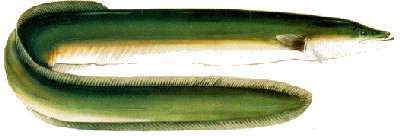
Anguilla rostrata
Size
to 60"
Species Profile
By Jeff Brust,
Research Scientist
American eels are an ecologically unique and important species that occur in fresh, brackish, and marine waters from the southern tip of Greenland to northeastern South America. This species is closely related to the European eel. Eels support a valuable commercial food fishery, are used widely as bait for sport fish such as striped bass and cobia and are an important food source for many fish and wildlife species.
More: American Eel ...
- Midwater Fishes ...
- Bottom Fishes ...
- Shellfish ...
- Insects ...
- Plants ...
- Reptiles & Amphibians ...
- Birds ...
- Freshwater Mammals ...
More: Freshwater ...

